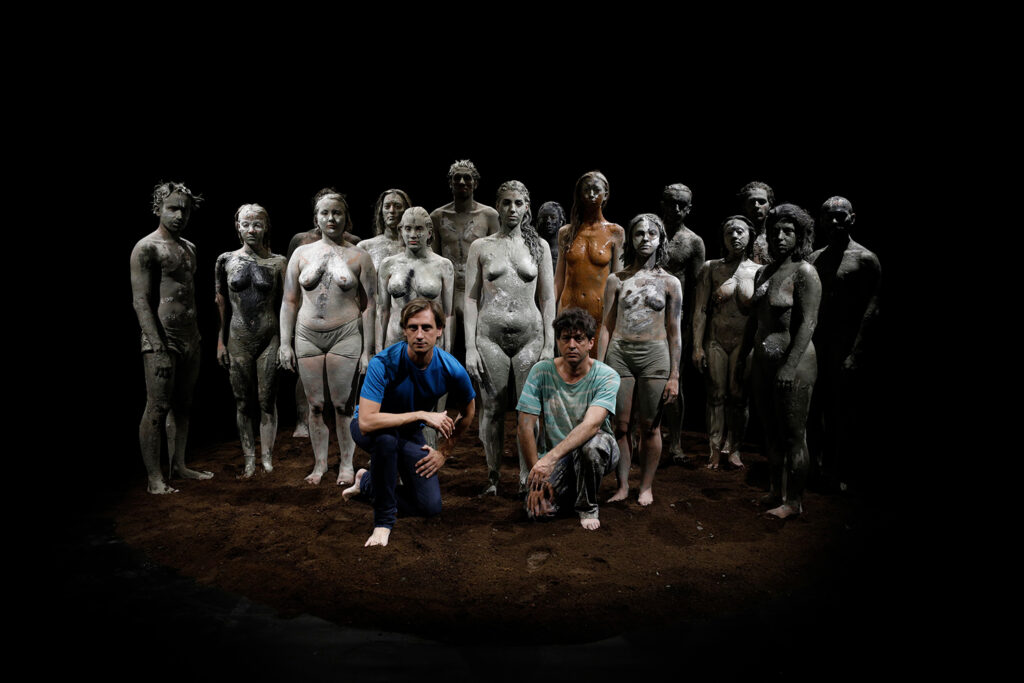
In collaboration with
Il Corso di Alta Formazione Teatrale di Teatro Due
Casa degli Artisti
APE Parma Museo
Lessico Animale. Prologo showcases a singular work that unites in one vision performance, music, photography, video, installation, theater, sculpture, and painting. This is the fruit of the artist’s creative process, who for this occasion collaborated with nineteen actors, students of the Casa degli Artisti Advanced Training Course at Teatro Due in Parma.
In “Lessico Animale,” Yuval Avital leads the Casa degli Artisti students through a complex transformation process. From actors, they become performers, then animals, and finally, in a new way, humans again. In the world theater, understood etymologically as a space that opens up to view, both for looking and for being looked at, the performers enter into a relationship with themselves and with others. They traverse states of poeticity, reflectiveness, alterity, and ultimately, reciprocity, through which every living being articulates their thought into language. The performance lasts six days, mirroring the genesis narrated by countless cultures. After a collective warm-up, the actors enter an installation reminiscent of the “circle of light,” akin to nomadic tribes gathered around a fire. Within the circle lies the visible: bodies, sounds, and dances. Outside it, the invisible: the unknown and indistinct primordial night. Avital’s circle is made of earth: the humus from which humankind originates and to which it is inexorably destined. Around this sacred space, nineteen clay statuettes, long pruned branches, bones as memento mori, and a series of mirrors are placed, serving both as vanitas and tools for bodily awareness. On a table, water, clay, pigments, and ash are seen, with which the artist will paint the performers’ bodies. Finally, there are also masks which, once worn, will mark the transformation into animals. It begins with a series of exercises through which the performers explore the primordial archetypes that unite and separate men and animals: among many, “the mother,” “the father,” “the secret,” “the guide animal.” Blindfolded, they explore each other by touching, smelling, licking; they transpose their faces into their hands, their mouths multiply, arranged in pairs they form a heart that pulses in a systole and diastole suggested by the joined bodies.
The exercises then prepare for the scenes: the performers, painted by Avital, become ibexes, cats, crows, boars, lions, rabbits, sheep, wolves, donkeys. Through them, the symbol reaches the essence of youth, mourning, protective strength or gregarious violence, care and attack, fragility. Sometimes, the dynamic playwright intervenes in the artist’s gestural process and brings in the word: as a reference, shelter, an all-too-human tool. The entire process is filmed and photographed by the artist, who also makes casts of the performers’ bodies: as ruins of chaos, traces of the original opening to being. Or as ruins of our time that those who survive may, perhaps, rediscover one day.
Yuval Avital’s “Lessico Animale,” exploring the active-dynamic nature of the universe, transcends the illusory opposition between humanity and animality, presented from the title as a paradox. The category of ‘lexicon,’ as a properly human formulation, should in fact exclude – or dominate – that of ‘animality.’ The solution to the apparent contradiction is found precisely in the medieval tradition of bestiaries, where the immense project of the Bestiario della Terra takes root. In the Middle Ages, the animal is a sign with which to understand the liber naturae.
Yuval Avital delves into ancestral archetypes in a rite that places contemporaneity on both a pre and post-human level. In fact, it combines two types of initiation, the artistic – of τέχνη – and the mystic – of μυστικός. From this perspective, human and animal dialogue, never excluding each other. The result is a manifesto work of the limen, that boundary zone between performance art and theater, between the visual and the performative. Like a tragedy, “Lessico Animale” unfolds in a prologue and a series of acts. The prologue documents the transformation, through photographs, videos, interviews, etc. Like any lexicon, it is itself destined for further transformations, depending on how it extends in space and time. Yuval Avital’s language, according to the famous formula by Roland Barthes, “is a skin,” an outward manifestation of an atavistic depth to which it adheres, depends on, nourishes, and for which it is also bark, protection, and epiphany.